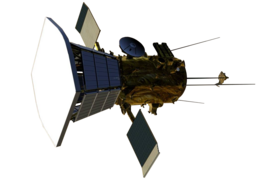
Back Parker-sonverkenningstuig AF مسبار باركر الشمسي Arabic Sonda Parker AST Parker Solar Probe AZ Паркер (сонечны зонд) BE Слънчева сонда Bulgarian Svemirska letjelica Parker BS Sonda solar Parker Catalan Parker Solar Probe Czech Parker Solar Probe German
 Model of the Parker Solar Probe spacecraft | |||||||||||||||
| Nama | Solar Probe (–2002) Solar Probe Plus (2010–17) | ||||||||||||||
|---|---|---|---|---|---|---|---|---|---|---|---|---|---|---|---|
| Jenis misi | Solar heliophysics orbiter | ||||||||||||||
| Operator | NASA · Applied Physics Laboratory | ||||||||||||||
| COSPAR ID | 2018-065A | ||||||||||||||
| SATCAT no. | 43592 | ||||||||||||||
| Situs web | solarprobe.jhuapl.edu | ||||||||||||||
| Durasi misi | 6 years, 321 days (planned) | ||||||||||||||
| Properti wahana | |||||||||||||||
| Produsen | Applied Physics Laboratory | ||||||||||||||
| Massa luncur | 610 kg | ||||||||||||||
| Massa kering | 555 kg | ||||||||||||||
| Massa muatan | ~50 kg | ||||||||||||||
| Dimensi | 1x3 m, 2.3 m heat shield | ||||||||||||||
| Daya | 343 W (at closest approach) | ||||||||||||||
| Awal misi | |||||||||||||||
| Tanggal luncur | July 31, 2018 (planned)[1] | ||||||||||||||
| Roket peluncur | Delta IV Heavy | ||||||||||||||
| Tempat peluncuran | Cape Canaveral SLC-37 | ||||||||||||||
| Parameter orbit | |||||||||||||||
| Sistem rujukan | Heliocentric | ||||||||||||||
| Ketinggian perihelion | Error in convert: Value "3,700,000" must be a number (help) | ||||||||||||||
| Ketinggian apohelion | Error in convert: Value "67,900,000" must be a number (help) | ||||||||||||||
| Inklinasi | 3.4° | ||||||||||||||
| Periode | 88 days | ||||||||||||||
| Transponder | |||||||||||||||
| Pita | Ka band X band | ||||||||||||||
| |||||||||||||||
 Official insignia for the Parker Solar Probe mission | |||||||||||||||
Parker Solar Probe (sebelumnya Solar Probe dan Solar Probe Plus, atau Solar Probe +) adalah pesawat ruang angkasa NASA yang direncanakan untuk menyelidiki korona luar Matahari.[2][3] Ini akan mendekati radius 8.5 surya (5,9 juta kilometer atau 3,67 juta mil) ke 'permukaan' fotosfer Matahari.[4] Proyek ini diumumkan sebagai awal misi baru pada tahun fiskal 2009 anggaran. Pada tanggal 1 Mei 2008, Laboratorium Fisika Terapan Johns Hopkins mengumumkan akan merancang dan membangun wahana antariksa, sesuai jadwal untuk diluncurkan pada tahun 2015..[5] Tanggal peluncurannya telah didorong kembali ke 2018,[6] dengan Delta IV Heavy sebagai kendaraan peluncuran.[1] Pada 31 Mei 2017 probe berganti nama setelah astrofisikawan surya Eugene Parker.[2][7] Menurut NASA, ini adalah pertama kalinya dalam sejarah sebuah kapal luar angkasa diberi nama menurut orang yang hidup.[8]
- ^ a b Clark, Stephen (Mar 18, 2015). "Delta 4-Heavy selected for launch of solar probe". Spaceflight Now. Diakses tanggal Mar 18, 2015.
- ^ a b Chang, Kenneth (May 31, 2017). "Newly Named NASA Spacecraft Will Aim Straight for the Sun". New York Times. Diakses tanggal June 1, 2017.
- ^ Applied Physics Laboratory (19 November 2008). "Feasible Mission Designs for Solar Probe Plus to Launch in 2015, 2016, 2017, or 2018" (.PDF). Johns Hopkins University. Diakses pada 27 Februari 2010. "Salinan arsip" (PDF). Diarsipkan dari versi asli (PDF) tanggal 2016-04-18. Diakses tanggal 2017-06-11.
- ^ Tony Phillips (2010-06-10). "NASA Plans to Visit the Sun". NASA. Diakses tanggal 2017-06-02.
- ^ M. Buckley (2008-05-01). "NASA Calls on APL to Send a Probe to the Sun". Johns Hopkins University Applied Physics Laboratory. Diarsipkan dari versi asli tanggal 2010-11-20. Diakses tanggal 30 September 2010.
- ^ M. Buckley (2012-03-05). "NASA Solar Study Mission Moves to Next Design Stage". Johns Hopkins University Applied Physics Laboratory. Diarsipkan dari versi asli tanggal 2012-03-12. Diakses tanggal 12 March 2012.
- ^ N. Davis (2017-05-31). "Nasa's hotly anticipated solar mission renamed to honour astrophysicist [[Eugene Parker]]". The Guardian. Diakses tanggal 31 May 2017. Konflik URL–wikilink (bantuan)
- ^ "NASA Renames Solar Probe Mission to Honor Pioneering Physicist Eugene Parker". NASA. 31 May 2017. Diakses tanggal 31 May 2017.